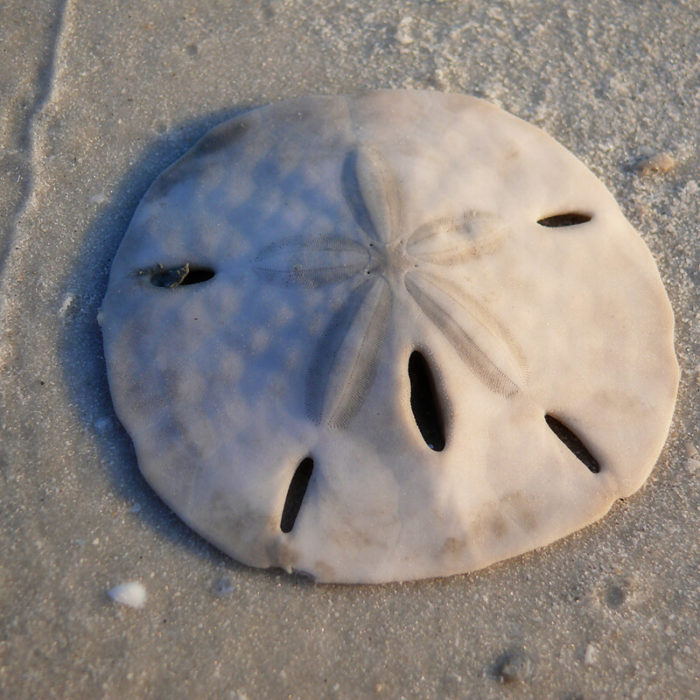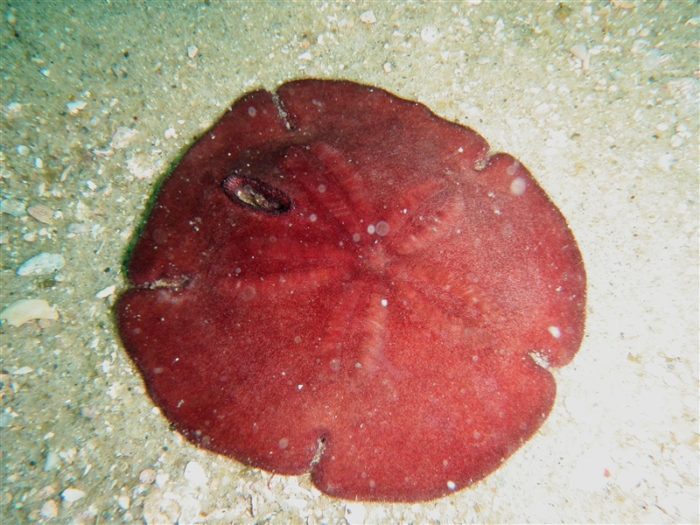
Sea Wonder: Sand Dollar

Photo credit: Kat Photos
They are neither sand nor currency, but sand dollars (order Clypeasteroida) are a well-known symbol associated with days at the beach. You may be most familiar with their exoskeletons, which are disc-shaped and have radial patterned grooves or imprints that look like stars, which often wash ashore. Living sand dollars are covered in soft tube feet or tentacles that they for many different functions, and these tube feet make them look and feel fuzzy. While they might not seem that complex, sand dollars lead quite interesting lives.
Description
Sand dollars are small invertebrates that live near coastal areas throughout the global ocean. Their distinctive exoskeletons sport a star shape at the center of their disc-like bodies. The tube feet and keratinous spines covering their bodies make living sand dollars look and feel like velvet. Common colorations of sand dollars are gray, dark purple, pink, red, and charcoal.
The tube feet help with everything from feeding to motion, to drawing oxygen from the surrounding environment. Sand dollars have two sides, one that contains the mouth and one that does not. When they move along the sandy sea floor, sand dollars lay flat with their mouths facing down so they are protected and can feed on any tasty morsels that might cross their paths during their journey.
Depending on the species of sand dollar, adults can reach diameters of between two and four inches and often weigh less than an ounce. Many people recognize sand dollars as something to collect from the seashore and consider them to be sea shells, but they are actually related to urchins, sea cucumbers, and sea stars.
Diet and Habitat
Sand dollars are filter feeders that feed opportunistically, meaning they are not picky. The tube feet and spines covering their bodies help them filter plankton and other small organisms from the water column. They commonly snag phytoplankton or algae and zooplankton like crustacean or fish larvae. Unlike their sea star cousins, sand dollars are not active predators, and they cannot eat prey that are larger than their own bodies. Once ingested, it can take nearly two days for a sand dollar to fully digest its meal. Once it has, it expels the byproducts back into the environment through its mouth.
Sand dollars are found throughout the global ocean, most commonly in shallower coastal waters, though some species do live further offshore. One species of sand dollar, Clypeaster subdepressus, is common along the Pacific and Atlantic coasts of the Americas and throughout the Pacific Islands. Along with the marine sanctuaries along North America’s east and west coasts, sand dollars can be found in and near Hawaiian Islands Humpback Whale National Marine Sanctuary and the National Marine Sanctuary of American Samoa. When waters are calm, sand dollars are often half buried in the sand and half exposed to the waters around them; when waters are choppier, they are almost always lying flat and bury themselves along the sea floor.
Life History
Sand dollars reproduce using a strategy known as broadcast spawning, which corals and some species of fish also use. During spawning periods, males and females aggregate and release clouds of sperm and eggs into the water at the same time, which then randomly collide and fuse to form embryos. Tens or even hundreds of thousands of embryos result from each spawning event, but far fewer survive into adulthood. The spawning strategy does increase the survival rate of sand dollars by increasing the likelihood of fertilization and decreasing the risk of predation. Once formed, eggs take about three weeks to develop and hatch into larvae that begin growing arms when they are fully developed, usually by the time they are a few months old. Once sand dollars have eight arms, they settle onto the sea floor and transform or undergo metamorphosis, after which time they are considered juveniles that look much more similar to adult sand dollars. Over the next few years, juveniles grow and are considered adults when they reach their full body size and can reproduce. The maximum lifespan of a sand dollar seems to be between eight and 10 years old.
When sand dollars die, their spines fall off and leave behind their famous exoskeletons. If they aren’t eaten, many deceased sand dollars wash onto shore where they then bleach in the sun. This is how most people experience sand dollars and how many of us come to believe they are seashells that animals used for shelter rather than animals themselves.
Threats and Conservation
Sand dollars are important members of their ecological communities. Healthy sand dollar populations (both as larvae and as adults) support many ecologically and economically important species. Their primary predators include sea stars, crabs, and medium sized fish, and sand dollars are fairly easy to catch since they move slowly and have fairly simple defense mechanisms in the form of body spines and small stinging cells on their tube feet.
Population data about sand dollars is difficult to collect, making it unclear to scientists whether these populations are stable or at risk. Worldwide, sand dollars face anthropogenic or human-based threats, both directly and indirectly. Direct harms to sand dollar populations and ecosystems include bottom trawling, a method of industrial fishing that damages the sea floor, bycatch, and collection by divers. More indirect harms include physical and chemical pollution, habitat loss due to coastal development, and climate change and ocean acidification. Sand dollars generally do not receive government protections to ensure their long-term wellbeing.

A living sand dollar in Gray’s Reef National Marine Sanctuary. Photo credit: NOAA Photo Library
